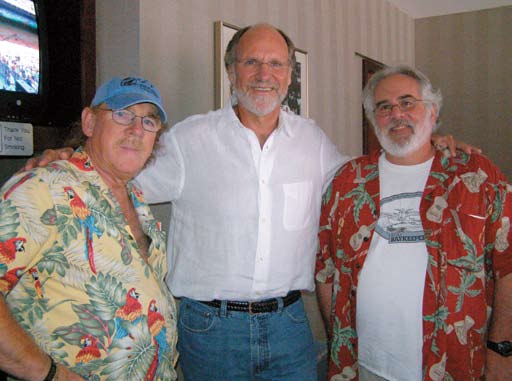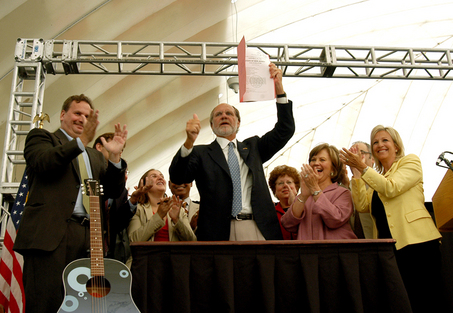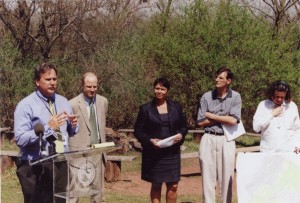Live Earth – A Retrospective

Live Earth – On July 6, 2007, Andy Willner, New York/New Jersey Baykeeper (right), and Captain Bill Sheehan (left), Hackensack Riverkeeper, joined Governor Corzine in his box at Giants Stadium for the Live Earth concert. The Waterkeepers thanked the Governor for signing New Jersey’s new Global Warming legislation into law that morning – no comment on shirts or waistlines.
“Partnerships with organizations like members of Waterkeeper Alliance allow us to leverage the abilities of these public interest organizations with the abilities of government and individuals. I look forward to continuing our strong working relationship as we work together to protect New Jersey’s environment for future generations.” Jon Corzine Fall 2007 Waterkeeper Magazine www.waterkeeper.org
Readers of this blog know that I am critical of how the ENGO community and the main stream media engage many issues, and that my accountability focus targets those efforts with the same standards I apply to polluters and government.
I believe that ENGO’s poorly serve their members and the public by not honestly telling them what is going on, due to a number of things: 1) a desire to avoid despair and to appear relevant and influential often results in setting a low performance bar. This allows groups to declare “victory”; 2) endorsing and praising politicians without securing real environmental commitments; 3) refusing to monitor and hold officials publicly accountable for performance; 4) continuing to give officials and government agencies like DEP a pass, even when they fail to deliver on commitments; and 5) playing insider “access” games and not involving the public or grassroots activists. All these tactics seriously set back the cause of environmental and public health protection.
These dynamics are referred to by some as co-optation: greenwash, or greenscam. I read Philip Selznick’s classic “TVA and the Grassroots” in college, and find his definition of co-optation to aptly describe a lot of what is going on:
“A tactic of neutralizing or winning over a minority by assimilating them into the established group or culture. A political process as a way of managing opposition and so preserving stability and the organization. … Outsiders are “co-opted” by being given formal or informal power on the grounds of their elite status, specialist knowledge, or potential ability to threaten essential commitments or goals”
So, today – hopefully to illustrate mistakes of the past to avoid repeating in the Christie transition – we take a retrospective look and do some accountability on “Live Earth“.
In addition to that Meadowlands concert (and press releases), Corzine took a page out of the Bush PR playbook and “bypassed the media filter”. To do so, Corzine used the Waterkeeper’s own advocacy magazine to make a series of exaggerated, inaccurate, and/or highly self serving and misleading statements touting his environmental achievements. As far as I know, he was never held accountable for those claims or for his performance by NJ Riverkeepers. Thus, in an effort to do so, here are the verbatim Corzine claims from that magazine, followed by the facts:
Corzine on Water Quality:
Earth Day 2007 Photo Op – classic co-optation tactic
Over the past few years, we have launched a number of major Clean Water Initiatives to protect New Jersey’s water resources. This past Earth Day, Commissioner Jackson proposed special protections for more than 900 miles of waterways and 1,300 acres of reservoirs that supply drinking water to millions of New Jerseyans. Additionally, the commissioner advanced a regulatory proposal that would vastly improve wastewater management statewide. Eventual adoption of this protection will mean safer drinking water for New Jersey’s families and cleaner habitats for rare species of wildlife. The proposal offers New Jersey the highest level of water quality protection, limiting development impacts and discharges of pollutants to streams, rivers and lakes, and ensuring no further degradation to waters that support critical wildlife or feed drinking water sources.
New Water Quality Management Planning Rules were also proposed on Earth Day. These proposed changes will strengthen our ability to shield environmentally fragile areas from the threats that invariably accompany inappropriate development. For the first time, these proposed rules address the impacts of septic systems on groundwater and establish new standards for wastewater management planning, removing environmentally sensitive lands from sewer service areas.
The recently proposed Flood Hazard Area Control Rules seek to clarify and reorganize New Jersey’s regulations to limit new development in flood plains. Current buffer zones of 25 to 50 feet would increase to 50, 150 or 300 feet depending on the category of the waterway. …
The Department of Environment Protection is in the process of updating the State’s Water Supply Master Plan, which is a critical tool for smart growth. We expect the revision to be completed next year. The final plan will provide a blueprint for managing the state’s water resources over the next 50 years and will ensure sufficient water supply in all parts of the state. It will also recognize that proper management is not just having an adequate potable supply, but ensuring a healthy ecosystem as well.
Our current Stormwater Management Rules emphasize low impact building techniques that will prevent and minimize impact on new development sites using both structural and non-structural techniques such as minimizing land disturbance, minimizing impervious cover, infiltration basins and vegetative filters. The design and performance standards for new development include groundwater recharge, runoff quantity controls, and stream buffers.
The Facts:
1. Category One program – yes DEP did propose more than 900 miles of C1 upgrades. However, DEP adopted less than 600, eliminating over 300 miles due to opposition from powerful corporate developers. Worse, DEP revised the C1 methodology, which makes it far more difficult to protect endangered species, water supply, and to list any additional C1’s in the future. This change in methodology was needless, because NJ’s highest court upheld a challenge to the C1 rules by the NJ Builders Association. The needless DEP change resulted in the elimination of over 1,600 backlogged qualified “candidate C1 waters” pending upgrade that were listed in the March 2003 NJ Register. Bottom line: the net effect was a huge setback, which was covered up by greenscam.
This rollback in the C1 program occurred, despite a January 2007 warning letter signed by numerous groups, strongly urging DEP Commissioner NOT to make the regulatory change. That leter read:
Dear Commissioner Jackson:
In a late December meeting attended by many of our groups, the Department outlined its plan for a new process to guide the designation of Category One waterways. The meeting afforded only a cursory overview of what would represent a very fundamental change to clean water protections in New Jersey, but did provide an outline of the narrow set of water quality indicators that might serve as the basis for deciding future C1 upgrades. We have serious objections to the proposed designation process and fear that its implementation would strip New Jersey of the ability to adequately protect and maintain its high quality waterways. If enacted, this method would reverse tremendous advances in clean water protection in the state, contradict the commitments made by Governor Corzine, and leave New Jersey without the ability to adequately protect and maintain many of its most deserving waterways.
Signed: Jeff Tittel, Sierra Club, NJEF, ANJEC, Environment NJ, et al
2. Flood Hazard/stream encroachment – yes DEP did adopt new stream encroachment regulations. However, the technical standards in those rules were based on the status quo level of protection. DEP developed the standards based on an internal file review of hundreds of prior SE permits issued by DEP (personal communication, Vince Mazei, P.E., NJDEP). No additional flood protections, limits on development, or stream buffers were required by these new rules (with the exception of a limited new no net fill rule in the Passaic basin). In fact, the new SE rules created two major new loopholes, the first known as a “hardship waiver” to allow developers to avoid the C1 300 foot stream buffer bans on disturbance of soil and vegetation; and the second was the repeal of Lisa Jackson’s Administrative Order on an “equivalence demonstration”, thus making it far easier to reduce C1 300 foot wide buffers to just 150 feet. Bottom line: the net effect of the new rules was negative. Again, this was done in the fine print and masked by greenscam.
3. Water Supply Master Plan (WSMP) – It is now over 2 and 1/2 years later, and DEP has not yet proposed the WSMP Corzine took credit for back in July 2007. As a result, countless DEP approved development projects have escaped water supply restrictions, threatening the long run water supply availability and the sensitive ecosystems that depend on adequate water.
4. Stormwater Management rules – those rules were developed and adopted by the McGreeevey administration in 2004, so Corzine can take no credit for them. Worse, in fact, Corzine has reduced funding, staffing, and enforcement of those rules.
5. Water Quality Management Planning rules – yes DEP did adopt new WQMP rules. However, they were NOT the first time septics were ever addressed under those rules. Christie Whitman issued an Executive Order # 109 that involved septic reviews years ago. DEP weakened the proposed rule on adoption Water Quality Management Planning rules, N.J.A.C. 7:15 (pdf), and has imposed what amounts to a moratorium on actually implementing or enforcing the key provisions that Corzine takes credit for developing.
Specifically, in a July 14, 2009 letter, DEP Acting Assistant Commissioner Scott Brubaker explained why he was setting aside water anti-pollution rules because legislators had introduce a bill to bully DEP to bend over for favored projects:
The Department is also under pressure from the development community, which fears that the Department will unilaterally remove sewer service areas. Recently, legislation has been introduced that would extend the submission deadline. Together these added burdens would preclude the Department from adopting any new or updated wastewater management plan for the foreseeable future. Any Department effort to withdraw sewer service areas would encourage this legislation. View this DEP letter admitting political bullying
Corzine on Global Warming and Water Resources
Over the summer, global warming was in the forefront of the news with the release of the Union of Concerned Scientists Report on Climate Change in the Northeast and the Live Earth Concerts for a Climate in Crisis. In light of the lack of federal action, I signed into law the Global Warming Response Act, strengthening our commitment to this priority issue for the state. New Jersey is now the third state in the nation to mandate Greenhouse Gas reductions by law and the first to codify long-term reductions. The goals set forth are the most ambitious in the country, requiring a reduction of Green House Gas emissions to 1990 levels by 2020 (20 percent reduction) and further reductions of emissions to 80 percent below 2006 levels by the year 2050 (80 percent reduction).
We have already made significant progress in evaluating policies and measures to achieve these goals and build on the reductions we anticipate from the Regional Greenhouse Gas Initiative, a ten state cooperative effort to implement a regional mandatory cap and trade program in the Northeast and Mid-Atlantic addressing CO2 emissions from power plants. New Jersey plays a leadership role in this initiative, the first mandatory market-based program to reduce carbon emissions in the U.S. It will cap regional power plant CO2 emissions at current levels from 2009 through 2014 and mandates emissions reductions by 10 percent in 2019.
The facts:
1. Global Warming Response Act (GWRA) – The GWRA is seriously flawed and praise for it is exagerated (see: Star Ledger Op-Ed: No teeth in “tough” pollution law“). Now, two and 1/2 years after Corzine signed that law, the GWRA goals have not been implemented. DEP failed to meet deadlines for submitting an implementation plan to the Legislature and as shown absolutely no signs of any intent to adopt regulations to implement the law. Corzine has cut funding for science and staff required to develop and implement the program, while he has supported only voluntary, market based, and low cost emission control measures. .
2. Regional Greenhouse Gas Initiative (RGGI) – RGGI is a failure and fatally flawed. Green house gas Emissions are increasing sharply. RGGI’s so called emission caps will allow those emissions to increase 18% more before a 10% reduction planned for the out years 2015-2019. RGGI caps only apply to in state emissions by some powr plants, which emit just 15% of total emissions. And energy imports from dirty Midwestern coal plants are not regulated. The law caps emission fees at just $2 per ton, when economists recommend $60 – $100 per ton. And the law provides millions of dollars in subsidies (with money collected from consumers) to some of the worst polluters.

Riverkeeper wasn’t the only ENGO with Corzine at Live Earth
